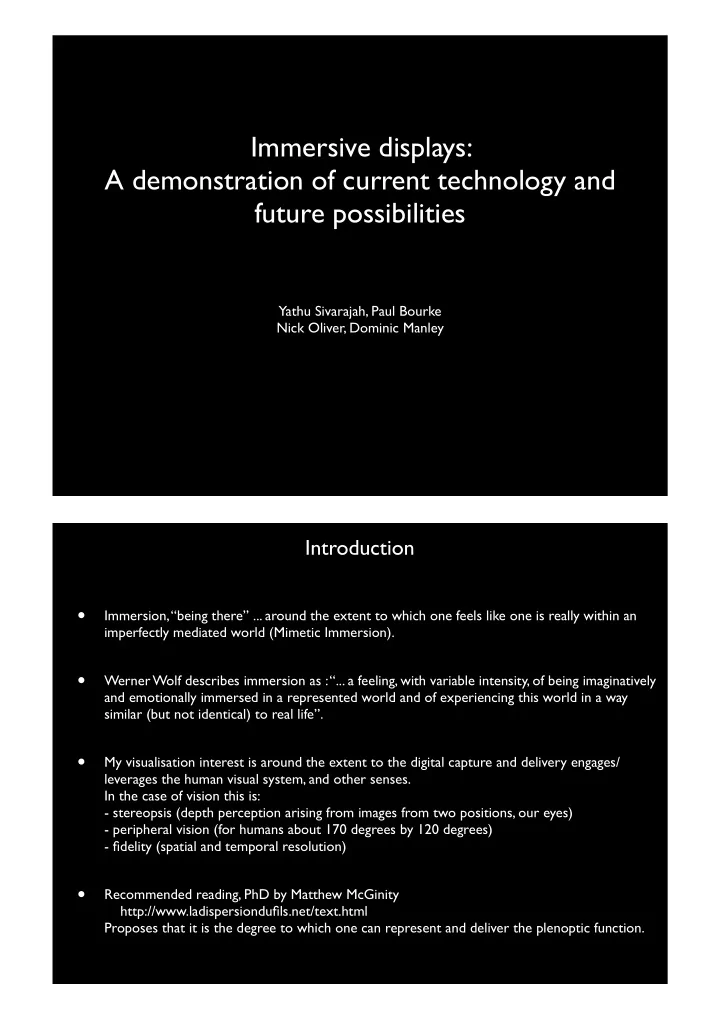

Immersive displays: A demonstration of current technology and future possibilities Yathu Sivarajah, Paul Bourke Nick Oliver, Dominic Manley Introduction • Immersion, “being there” ... around the extent to which one feels like one is really within an imperfectly mediated world (Mimetic Immersion). • Werner Wolf describes immersion as : “... a feeling, with variable intensity, of being imaginatively and emotionally immersed in a represented world and of experiencing this world in a way similar (but not identical) to real life”. • My visualisation interest is around the extent to the digital capture and delivery engages/ leverages the human visual system, and other senses. In the case of vision this is: - stereopsis (depth perception arising from images from two positions, our eyes) - peripheral vision (for humans about 170 degrees by 120 degrees) - fidelity (spatial and temporal resolution) • Recommended reading, PhD by Matthew McGinity http://www.ladispersiondufils.net/text.html Proposes that it is the degree to which one can represent and deliver the plenoptic function.
Light field • The “light field” is the infinity of 3D points through which innumerable light rays diverge and converge. • Converging rays arriving at any single point of the light field can be described by a spherical image of the world seen from that single position. • The part of the light field we observe are the two spherical images located at the position of our eyes. • The plenoptic function is a 7 dimensional function of position (3 variables), polar angle (2 variables), wavelength and time. Requirements • An ideal immersive display needs to represent the light field at a level that reaches the capabilities of the human visual system. • Any (current) display is only an approximation of the light field, display artefacts are: Display artefact Display Feature Limitation of L() Frame Limited field of view Pixels Resolution False colour Colour gamut Colour banding Colour depth Low contrast / brightness Dynamic range Noise Signal to noise Lag Latency Refresh rate / flicker / jitter Frame rate McGinity
iDome • First developed in 2003 jointly with UNSW. • Main applications to date - truck driving simulator for the mining industry (UNSW Centre for Mining) - cultural heritage (CityU, Museum Victoria) - education / teacher training (ECU) - science visualisation - exhibits in museums and art galleries Mawsons huts simulator Molecular simulation Ngintaka exhibition, Museum of South Australia Oculus Rift • Crowd sourced (Kickstarter) project in 2011. • First development version released late in 2012, second release in 2014. • Company acquired by Facebook in 2014. • Presents (optionally) - a stereo image pair - approximately 100 degrees FOV - 960x1080 max pixels per eye - inertia and camera for 3 axis rotation and position tracking
Another path: Tiled or projected displays • Another path might be a tiled display, possibly surrounding the viewer. Even a flat display of high enough resolution can occupy a wide field of view. • Head tracking provides consistent views. • Can optionally support stereo3D. • Tiled vs projected is largely a trade-off between resolution and bezels. ... presentation of this type of display will be left for another day. (Rough) Comparison iDome Oculus Tiled display Price Medium Low Medium to high Stereo3D Possible but difficult Yes Possible Horizontal field of Variable 180 100 view (low to high) Resolution 1600 pixels 960 pixels Generally very high Head tracked No Yes Yes Varies Audience 2-3 (Ideally 1) 1 (1 to 10) • Note: the tiled display column is more vague since it isn’t a single entity, there are lots of possible configurations.
Live demonstration • Content types - 360 spherical panorama image (2D) - 360 stereo3D cylindrical panorama image (limited vertical FOV) - 360 spherical panorama movie (2D) - 3D virtual environments based upon Unity3D • Introduce the team: Yathu Sivarajah, Paul Bourke, Nick Oliver, Dominic Manley
Recommend
More recommend